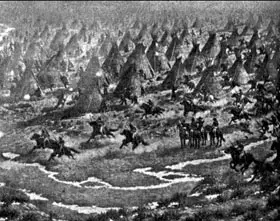Civil War Battles |
Colonial Wars |
American Wars |
Link To This Page — Contact Us —
The Battle of Sand Creek/Chivington Massacre
November 29-30, 1864 in Kiowa County, Colorado
Col. John Chivington
| Forces | Killed | Wounded | Captured |
| 950 | - | - | - |
Indian Forces Commanded by Black Kettle, Cheyenne
| Forces | Killed | Wounded | Captured |
| 500+ | 200 | - | - |
**Missing and Captured
Conclusion: Union Victory

BATTLE SUMMARY
The Sand Creek Massacre (also known as the Chivington Massacre) was an infamous incident in the Indian Wars out west that occurred when Colorado Militia troops in the Colorado Territory massacred an undefended village of Cheyenne and Arapaho encamped on the territory's eastern plains.
The attack was initially reported in the press as a victory against a bravely-fought opponent. Within weeks, however, eyewitnesses came forward offering conflicting testimony, leading to a military investigation and two Congressional investigations into the events.
Starting in the late 1850's, the gold rush in the Rocky Mountains, then part of the western Kansas Territory, had brought a flood of white settlers into the mountains and the surrounding foothills. The sudden immigration came into conflict with the Cheyenne and the Arapaho Indians who inhabited the area, eventually leading to the Colorado War in 1864.
Conflict between the Native Americans and the miners spread, and the Cheyenne and Arapaho tribes made wagon travel extremely dangerous across Colorado's eastern plains. The warriors had been harassing white settlers with scattered Indian raids. Territorial governor John Evans sent Col. John Chivington to quiet the Indians at the head of a locally-raised militia. After a few skirmishes and an effective warpath on the part of the Indians, many of the Cheyennes and Arapahos were ready for peace and camped near Fort Lyon on the eastern plains.
Early in September, Maj. Edward W. Wynkoop arranged a peace meeting between Gov. John Evans of Colorado Territory and several chiefs from the Arapaho and Cheyenne Indian tribes. When he received word of Wynkoop's plans, commanding Gen. Samuel R. Curtis sent word that there would not be any peace could be made until he approved the terms and until the guilty Indians first were punished for their depredations.
Both of the tribes had recently signed a treaty with the United States in which they ceded their lands to the United States and agreed to move to the Indian reservation to the south of Sand Creek in Oklahoma, demarcated by a line to be run due north from a point on the northern boundary of New Mexico, 15 miles west of Purgatory River, and extending to the Sandy Fork of the Arkansas River.
Black Kettle, one chief of a group of mostly Southern Cheyennes and some Arapahoes, some 800 in number, reported to Fort Lyon in an effort to declare peace.
While the Indians waited for negotiations to begin, they camped at Sand Creek, 40 miles northeast of Fort Lyon, believing they were safe, having complied with the white man's demands to lay down their arms. Feeling comfortable he sent out most of his warriors to hunt. Against the advice of military officers and civilians, Col. John M. Chivington, commanding the District of Colorado under Curtis, led the 950 100-day men of the 3rd Colorado Cavalry, the 1st Colorado with its 2 howitzers, and a detachment of the 1st New Mexico Infantry in reprisal against the Indians. The men of the 3rd Colorado had been recruited to put down the outbreak of hostilities that had begun after the Regular Army was transferred east in 1861. With their enlistments about to expire, they were eager for revenge.
On November 29, at sunrise, Chivington's troops reached the Indian village. To prevent escape, they seized the Indians' ponies and unlimbered the howitzers, training them on the still-sleeping Cheyennes and Arapaho. Soldiers attacked the village from 3 sides. When he saw the troops approaching, Black Kettle, chief of the Cheyenne, raised the U.S. flag over his lodge as a gesture of peace. Chivington also ignored the pleas of interpreter John Smith to break off the attack, and his men began shooting indiscriminately, following his orders to not take any prisoners.
Some of the warriors seized their weapons and formed a battle line 1/2 mile above the camp at Sand Creek, but their defense collapsed before overwhelming odds. The Indians contested the soldiers' pursuit for 5 miles before dispersing into the countryside. One officer, Capt. Silas Soule, a Massachusetts abolitionist, refused to follow Chivington's orders. He did not allow his cavalry company to fire into the crowd.
Estimates of the number of Indians at the encampment range between 500-1,000; 400-600 were killed, many of them women and children whose bodies had been mutilated.
Public reactions to the brutal massacre ranged from approval to condemnation, but many blamed Chivington for having committed an unpardonable act of violence that resulted in a renewed outburst of hostilities.
This massacre is cited as a critical cause of the Battle of Little Big Horn, as many formerly uninvolved Cheyenne warriors devoted their lives to war against the U.S. in response.
At first, Chivington's victory was greeted with acclaim in Denver and the Colorado Territory, but this did not last long. The grisly displays of battle tropies of Indian scalps and body parts were reportedly very disturbing.
As the details came out, the public was shocked by the brutality of the massacre and the U.S. Congress decided to investigate Chivington's role. Soule was eager to testify against him. After he testified, Soule was murdered by Charles W. Squires and it is believed that Chivington was behind this murder.
In 1865, Sen. James R. Doolittle headed a congressional committee investigating the massacre. The proceedings ended in a denunciation of Chivington, ruining his military career. The Indians were not checked until the confederate surrender freed regular Army troops to return to duty on the frontier.
